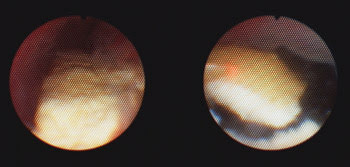Laser is used for treatment of bladder and prostate problems and kidney stones.
Dr. Adam C. Mues and Dr. Bodo E. Knudsen, Ohio State University Medical Center
The holmium:YAG laser is widely used in urologic surgery. The solid-state laser is available in variable power configurations from 10 to 100 W and is released in a pulsed-mode system, allowing high-energy delivery to tissue while limiting the amount of surrounding thermal damage.
The laser operates at a characteristic wavelength of 2140 nm with pulse duration of 350 μs, which accounts for specific tissue interactions. The precise cutting, ablation and tissue coagulation properties are beneficial for treatment of urinary calculi and soft-tissue lesions. At this wavelength, light energy is absorbed by water in the tissue, leading to a depth of penetration limited to 0.5 to 1.0 mm and making the holmium laser a relatively safe treatment modality for the urinary tract.1
New gold standard
The Ho:YAG laser has become the new gold standard for intracorporeal lithotripsy (use of an energy source to break up a kidney stone in the urinary tract) when coupled with miniaturized ureteroscopes.2 Previously, this was done by using ultrasound passed through an endoscope, but the laser has more control over breaking up the stone with minimal propulsion. The fragmentation process occurs through a primary photothermal mechanism where the stone is broken up because it absorbs optical energy. The laser energy is sent through small silica fibers — with core sizes from 200 to 400 μm — that are compatible with both semirigid and flexible ureteroscopes. The Ho:YAG has been used in the treatment of bladder outlet obstruction, which sometimes occurs as a result of benign prostate enlargement.

A ureteral stone shown in its solid form (left) undergoes laser lithotripsy with a holmium:YAG laser (right).
The prostatic tissue is dissected using an endoscope, and laser ablation of the prostate is performed by systematically ablating its surface until an adequate cavity is formed. The technique is an introductory procedure that has a short learning curve and does not require resection or enucleation of tissue, although it is typically limited to smaller prostates.
Holmium laser resection of the prostate is performed by cutting the median and lateral lobes while they are attached to the surgical capsule. Following this, the lobes are cut into smaller fragments and removed with a modified resectoscope loop. The resectoscope is a hysteroscope designed specifically for bladder or prostate surgery. The scope has a wire loop that uses high-frequency electrical current to cut tissue.
Once enucleation of the prostate is completed, a morcellator removes tissue through the urethra. This technique is emerging as the true endourologic alternative to open prostatectomy for large prostates; however, because of its steep learning curve, widespread adoption has not yet occurred.
Another alternative
The holmium:YAG laser may serve as an alternative to balloon dilation, cold-knife or electrosurgical incision, and, possibly, open surgery in many urological procedures. Urinary tract lesions such as transitional cell carcinoma, fibroepithelial polyps and papillary hemangiomas may be successfully managed by the holmium:YAG laser. Tumors are coagulated after resection by activating the laser with the fiber close to but not touching the tumor. Ablation of the lesion requires direct contact with the fiber.
Because of the versatility of the holmium:YAG laser in urological procedures, it will likely play an active role for years to come.
Meet the authors
Adam C. Mues is a resident in urology at Ohio State University Medical Center in Columbus; e-mail: [email protected].
Bodo E. Knudsen is an assistant professor and the director of the Comprehensive Kidney Stone Program at the medical center; e-mail: [email protected].
References
1. A.J. Marks and J.M.H. Teichman (June 2007). Lasers in clinical urology: state of the art and new horizons. WORLD J UROL, pp. 227-233.
2. M. Sofer et al (January 2002). Holmium:YAG laser lithotripsy for upper urinary tract calculi in 598 patients. J Urol, pp. 31-34.